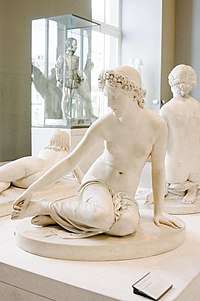Salmacis
In Greek mythology, Salmacis (Ancient Greek: Σαλμακίς) was an atypical naiad who rejected the ways of the virginal Greek goddess Artemis in favor of vanity and idleness. Her attempted rape of Hermaphroditus places her as the only nymph rapist in the Greek mythological canon (though see also Dercetis).
There dwelt a Nymph, not up for hunting or archery:
unfit for footraces. She the only Naiad not in Diana’s band.
Often her sisters would say: "Pick up a javelin, or
bristling quiver, and interrupt your leisure for the chase!"
But she would not pick up a javelin or arrows,
nor trade leisure for the chase.
Instead she would bathe her beautiful limbs and tend to her hair,
with her waters as a mirror.— Ovid, Metamorphoses. Book IV, 306–312.
| Greek deities series |
|---|
| Nymphs |



In Ovid's Metamorphoses, she becomes one with Hermaphroditus and Hermaphroditus curses the fountain to have the same effect on others.
Salmacis fountain
Literature
Francis Beaumont, a poet and playwright, wrote a poem Salmacis and Hermaphroditus based on Ovid's work. The poem was published anonymously in London in 1602.[1] Algernon Charles Swinburne's 1863 poem "Hermaphroditus", based on the Bernini sculpture of the same in the Louvre, makes mention of Salmacis in the final stanza.
Music
- The British progressive rock band Genesis wrote and performed a song entitled "Fountain of Salmacis" on their 1971 album Nursery Cryme. It is an epic 8 minute-long piece which tells the story of Salmacis' attempted rape of Hermaphroditus. At the end of the song, the lyrics state that Salmacis and Hermaphroditus were "joined as one" and forever live beneath the lake from which the fountain appears.
Other
- The Fontana Greca ("Greek Fountain") is a fountain located in Gallipoli, southern Italy. The fountain has bas-reliefs depicting three metamorphoses in Greek mythology. The center bas-relief shows Eros flying beside Aphrodite, while Hermaphroditus and Salmacis are shown below laying together and embracing.
- A sculpture by François-Joseph Bosio, La nymphe Salmacis, can be seen on display at the Louvre Museum in Paris.[2]
- Ovid's story of Salmacis and the boy Hermaphroditus is retold by Francis Beaumont in his epyllion 'Salmacis and Hermaphroditus'.[3]
- In his poem "Hermaphroditus", Algernon Charles Swinburne mentions Salmacis.
- A novel of short stories by Italian writer Mario Soldati called Salmace (Salmacis), a title that spans the entire collection. In the story it tells of the transformation of a man into a woman, in a highly metaphorical context.[4]
- Within the fictional book "Complacency of the Learned" from the webcomic Homestuck, the name of the androgynous character Calmasis is an allusion to Salmacis.
References
- Francis Beaumont, Salmacis and Hermaphroditus.
- Sculpture: The Nymph Salmacis by François-Joseph Bosio, Louvre Museum, Paris
- Renascence Editions: Salmacis and Hermaphroditus by Francis Beaumont Luminarium.org
- Soldati, Mario (1929). Salmace. Edizioni La Libra.
External links
| Wikimedia Commons has media related to Salmacis. |